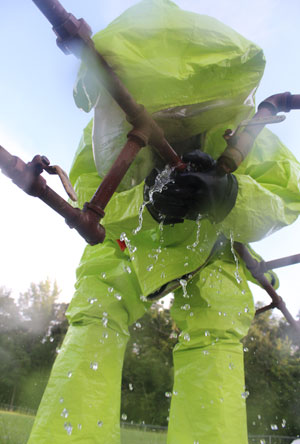The state's industrial capacity and the network of interstate highways and railways result in vulnerabilities to hazardous material releases from both stationary sites and transportation sources. Facilities that use or store hazardous materials are located throughout the state in both rural and densely populated areas and do not include retail gas stations or telephone relay battery storage sites. Many facilities are located in coastal counties that could be impacted by hurricane force winds and rains. Toxic release inventories indicate combinations of fixed sources are clustered along Interstate 85. While the greatest number of facilities are concentrated along that route, numerous other facilities, more evenly spread across the state, emit greater amounts. Further, the extensive network of interstate highways and railways that supply industries with chemical and petroleum products could result in a moderate to large accidental release of hazardous materials from a transportation source.

Hazardous materials are chemical substances, which if releases or misused, can pose a threat to health or the environment. These chemicals are used in industry, agriculture, medicine, research and consumer goods. As many as 500,000 products pose physical or health hazards and can be defined as "hazardous chemicals." Each year, over 1000 new synthetic chemicals are introduced. Hazardous materials come in the form of explosives, flammable and combustible substances, poisons, and radioactive materials. These substances are most often released as a result of transportation accidents or because of chemical accidents in manufacturing plants.
However, most victims of chemical accidents are injured at home. These incidents usually are the result of carelessness or ignorance in the use of chemical products. The use of these chemical products has become a necessity in our society. We depend on them to protect us from disease and contribute to our high standard of living. It is important to remember that the products we use to clean, disinfect, and maintain our homes, clothing, dishes, furnishings, etc. are designed to be safely used, stored and disposed of in the home. These accidents occur when they are used or disposed of improperly. As with all the materials in our homes, you should follow manufacturer’s labels on proper ways and improper ways to use and dispose of all types of chemical products.
You may be exposed to a chemical in three ways:
1. Breathing the chemical
2. Swallowing contaminated food, water or medication.
3. Touching the chemical, or coming into contact with items that touched the chemical.
Remember, you may be exposed to chemicals even though you may not be able to see or smell anything unusual. Many hazardous materials do not have a taste or an odor. There are different ways to detect the presence of a hazardous material. Some materials can be detected because they cause physical reactions such as watering eyes or nausea. Some hazardous materials exist beneath the surface of the ground and can be recognized by an oil or foam-like appearance.
Learn about chemicals and chemical emergencies. Chemicals are everywhere and are an important part of everyday life. The best way to protect yourself and your family is to be prepared. Knowing what to watch for and how to respond will keep you alert to potential chemical hazards.
Click here for a copy of the LEPC Planning Booklet.
If you ever have questions about Sara Title III Reporting we hope this section will help answer them. If something is not covered please feel free to call our office (843-665-7255) and we will do our best to answer any questions you may have.
